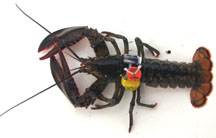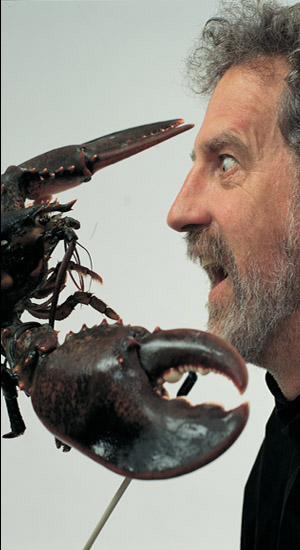Please select a Topic:
Other Useful Links:
Contact Information
Email: win@unh.edu
Phone: 603-862-1629 (office)
Phone: 603-862-4019 (lab)
Office: 179 Rudman Hall
Lab: 135 Rudman Hall
Mailing Address:
Dept. of Biological Sciences
UNH
Durham, NH 03824
|
Lobster Behavior, Physiology and Ecology
 We use ultrasonic telemetry, underwater video and laboratory experiments to investigate the factors that influence the behavior of lobsters in their natural habitat. When possible, we also use this information to understand trends in the lobster fishery. Current projects focus on acoustic communication, behavior around traps, mating, and the linkages between seasonal movements of egg-bearing lobsters, egg development, and larvae hatching, drift and settlement. (more)
We use ultrasonic telemetry, underwater video and laboratory experiments to investigate the factors that influence the behavior of lobsters in their natural habitat. When possible, we also use this information to understand trends in the lobster fishery. Current projects focus on acoustic communication, behavior around traps, mating, and the linkages between seasonal movements of egg-bearing lobsters, egg development, and larvae hatching, drift and settlement. (more)
|
Horseshoe Crab Biological Rhythms
 Limulus express both circadian and tidal rhythms of activity
in the laboratory. We are seeking to determine if these rhythms are also expressed in the field and what types of environmental cues influence the expression of these rhythms. In addition, we are using a variety of molecular techniques to identify the neurons in the CNS that control these rhythms (more)
Limulus express both circadian and tidal rhythms of activity
in the laboratory. We are seeking to determine if these rhythms are also expressed in the field and what types of environmental cues influence the expression of these rhythms. In addition, we are using a variety of molecular techniques to identify the neurons in the CNS that control these rhythms (more)
|
Fish Behavior and Physiology
 UNH is currently investigating ways to improve the aquaculture of fish such as trout and cod. My role in this project is to investigate the behavior of the fish within net pens using emerging technologies. (more)
UNH is currently investigating ways to improve the aquaculture of fish such as trout and cod. My role in this project is to investigate the behavior of the fish within net pens using emerging technologies. (more) |
Nudibranch Neurobiology and Behavior
Nudibranches are often studied by neurobiologists because they have very large, identifiable, neurons that are very amenable to neurophysiological investigations. Our studies of the nudibranch, Melibe leonina, center around their rhythmic behaviors, such as feeding and swimming. We seek to identify the neural circuits that generate the behaviors as well as the neurons and hormones that modulate the expression of these behaviors. Current work is focused on identifying neurons that are part of the circadian clock that modulates the expression of locomotion (more) |
|
|

|

